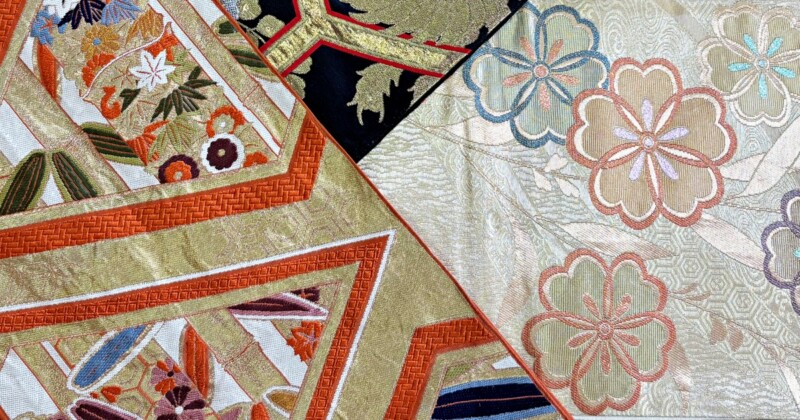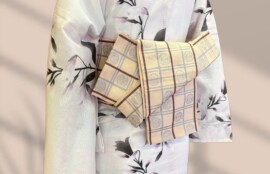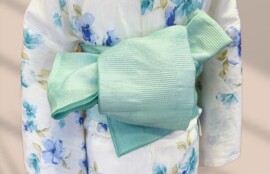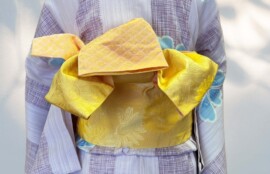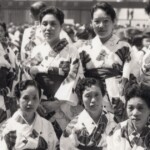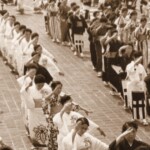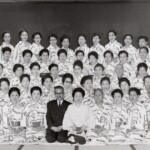The OBI is an essential item when wearing a Kimono.
But do you know that there are many different types of the OBIs? The OBIs are classified
according to whether they are woven or dyed and according to their shape.
Classification of OBI
|Woven or Dyed
It is generally said that “Dyed Kimono is of higher grade than Woven Kimono, but Woven OBI is
of higher grade than Dyed OBI.
The Woven OBI is a type of OBI that expresses a Woven pattern by revealing or hiding colored threads dyed with white threads. ‘NISHIKI ORI’ and ‘KARA ORI’ are typical examples and are
used for formal wear. ‘ORI’ means woven in Japanese. There are also other types of OBI
such as ‘HAKATA ORI’, ‘TSUZURE ORI’, and ‘TSUMUGI(pongee) OBI’. ‘TSUZURE ORI’ with
gold and silver threads is suitable for formal wear, but the rest are more suitable for casual wear.
The Dyed OBI is a white fabric dyed with a pattern which creates a soft and gentle atmosphere.
Dyeing techniques include Hand-Dyeing, Stencil Dyeing, Tie-Dyeing, Chintz Dyeing, and Waxen
Dyeing. Those decorated with gold and silver colors and prestigious patterns can also be used
as semi-formal wear.
|Shape
There are 4 main types of OBI shapes: In order of prestige, ‘MARU OBI’, ‘FUKURO OBI,
‘NAGOYA OBI’, and ‘HANHABA OBI’.
The ‘MARU OBI’ was invented around the middle of the Edo period and was used as formal
wear. It is made by a process that folds the OBI in half to form a pouch shape.
It looks gorgeous because it has the same pattern on both the front and back, but it is twice as
heavy and thick as the ‘FUKURO OBI’. The design is also gorgeous with gold and silver threads.
Today, it is mostly used as a special OBI for Maiko-san and brides.
The ‘FUKURO OBI’ is the second most prestigious OBI after the ‘MARU OBI’. It is called
the ‘FUKURO OBI’ because it is made by sewing together a plain lining and outer fabric into
a pouch shape. It is basically for formal wear, but it can also be used casually, depending on
the pattern or design. It is classified into 3 types according to where the pattern is applied:
‘ZENTSU GARA’, ‘ROKUTSUU GARA’, and ‘OTAIKO GARA’. It is also divided into
‘HON BUKURO’, ‘NUI BUKURO’, and ‘KATANUI BUKURO’, depending on how the outer and
lining fabrics are combined.
The ‘NAGOYA OBI’ is an improved version of the ‘FUKURO OBI’ that is easier to tie.
It was designed with the concept of “an active OBI for women’s social advancement”,
as a simplification of the double Otaiko style of the ‘FUKURO OBI’ into a single.
It was named ‘NAGOYA OBI’ because its creator was the founder of Nagoya Jogakko
(now Nagoya Aoi University). It is easy to tie, but that does not mean that it is abbreviated
version. Those with gold or silver threads are used for semi-formal wear. But it’s basically
used for daily use.
The ‘HANHABA OBI’ is named after its half-width and is the most casual OBI. Many of them
are reversible, and all-over patterns are common, so you can enjoy 2 different colors and
patterns and decide on the top and bottom of the OBI as you wish. Above all, you don’t need
any accessories such as Obijime, Obiage, or Obimakura, so you can easily enjoy knotting OBI,
but it is not suitable for formal wear.
In the End
There are various types of OBI, each with its own characteristics and different occasions
for tying them. Even if you are wearing the same Kimono, just by changing the OBI or the way
it is tied, it looks completely different. The OBI is not only an essential item for the Kimono,
but also a very useful item.
We hope you will learn various OBI Knot and enjoy wearing Kimonos!
At Japanese Dance School MIYA, we also offer the ‘Kimono Course’, where you can learn
how to wear a Kimono, including how to tie an OBI.
If you are interested, please contact us HERE.
*There are various theories about the origin of the name of the ‘NAGOYA OBI’.
*This site contains promotions.
◆CONTACT
https://miya-ds.com/en/contact/
◆TRIAL LESSON
https://miya-ds.com/en/trialsession/
◆JAPANESE DANCE SCHOOL MIYA
https://miya-ds.com/en/
◆MIYANAGI RYU
https://www.miyanagiryu.com

